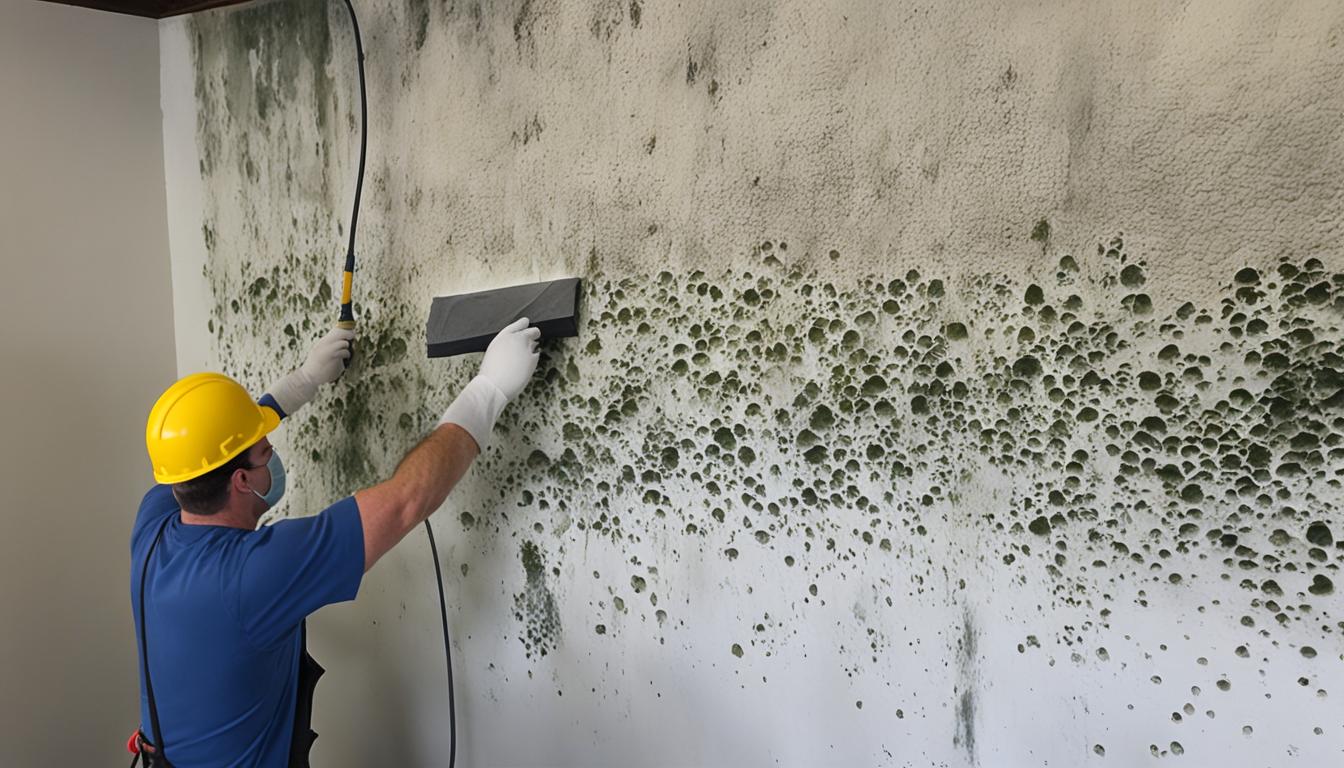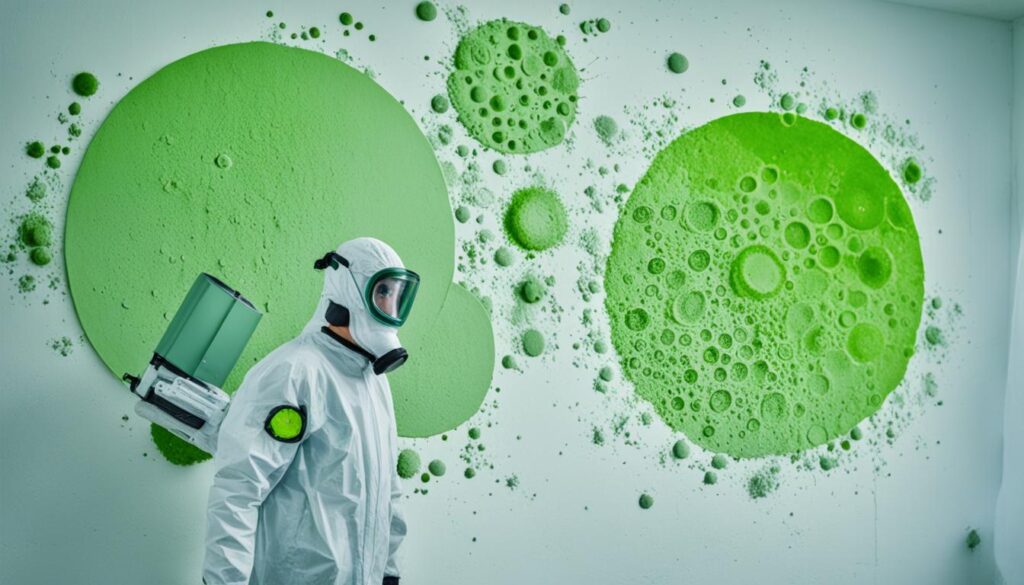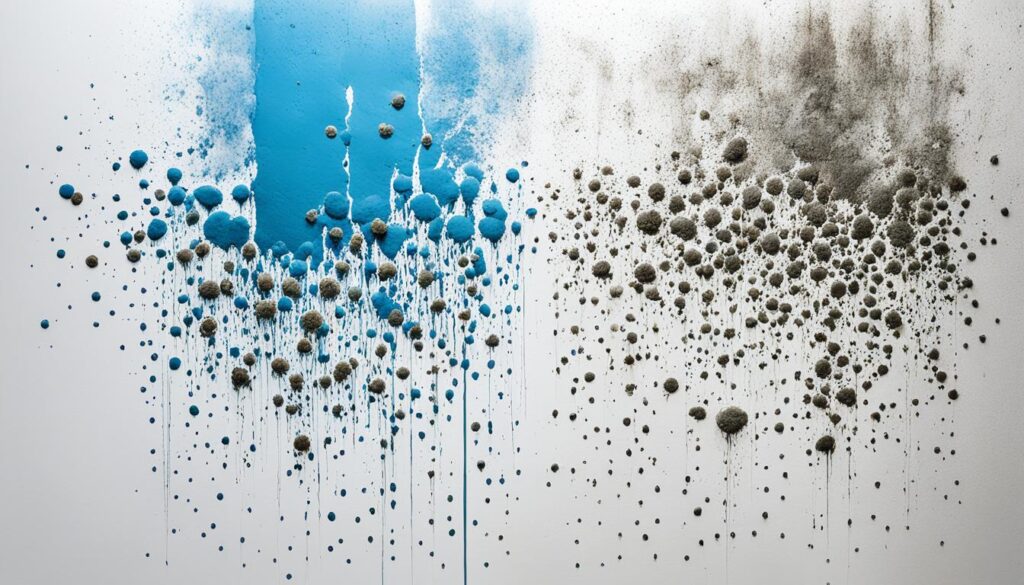
Eliminate Mold and Fungus from Walls Guide
Welcome to our comprehensive guide on how to remove mold and fungus from walls. In this article, we will provide you with effective strategies to safely eliminate these harmful substances from your home. By following our step-by-step instructions, you can maintain a healthy living environment and prevent further mold infestations.
Key Takeaways
- Removing mold and fungus from walls is crucial for maintaining a healthy home.
- Proper assessment of the infestation is essential before initiating the removal process.
- Determine whether DIY methods are suitable or if professional mold remediation services are necessary.
- Learn safe and effective DIY techniques for cleaning mold and preventing future growth.
- Consider professional mold remediation services for extensive or hazardous mold infestations.
Understanding the Risks of Mold and Fungus on Walls
Before diving into the cleaning process, it’s important to understand the risks associated with mold and fungus on walls. Mold and fungus are not only unsightly, but they can also pose significant health hazards to you and your family.
Mold spores can trigger allergic reactions, respiratory issues, and even lead to more severe health problems in individuals with compromised immune systems. Prolonged exposure to mold can result in symptoms such as coughing, sneezing, congestion, skin rashes, and eye irritation. In some cases, mold exposure may even cause asthma attacks or severe respiratory infections.
It’s crucial to prioritize prompt mold remediation to protect your health and maintain a safe living environment.
While minor mold infestations can be handled through DIY wall mold removal methods, it’s important to recognize the limitations. DIY approaches are best suited for small-scale outbreaks that cover an area of less than 10 square feet. Anything beyond that should be assessed and addressed by professional mold remediation services to ensure thorough elimination and prevent future reoccurrence.
If you choose to tackle DIY wall mold removal, take necessary precautions to protect yourself. Always wear protective gear such as gloves, goggles, and a mask to minimize your exposure to mold spores. Proper ventilation during the cleaning process is also crucial to prevent the spread of mold spores to other areas of your house.
When to Seek Professional Mold Remediation Services
In certain cases, it’s best to seek the expertise of professional mold remediation services. Consider the following scenarios:
- If the mold infestation covers a large area, typically over 10 square feet, professional intervention is recommended. Extensive mold growth indicates a more significant issue that requires specialized equipment and techniques for effective removal.
- When mold is a result of a structural problem such as a leaky roof, plumbing issues, or water damage, it’s crucial to address the root cause and seek professional assistance to prevent future mold growth and structural damage.
- If you or any family members have underlying health conditions that may be exacerbated by mold exposure, it’s safer to entrust the task to professionals who can ensure proper containment, removal, and remediation.
Professional mold remediation services have the expertise and resources to identify the extent of the mold infestation, identify the underlying causes, and provide effective treatment to eliminate the mold from your walls.
Ambrose Mold Remediation Services, with over 10 years of experience in mold remediation, offers comprehensive solutions tailored to your specific needs. Our team of trained professionals uses advanced techniques and equipment to thoroughly remove mold and fungus from your walls, ensuring a safe and healthy living environment for you and your family.
| DIY Wall Mold Removal | Professional Mold Remediation Services | |
|---|---|---|
| Extent of Mold Infestation | Small-scale outbreaks ( | Large-scale infestations (>10 sq ft) |
| Expertise | Basic knowledge of mold removal techniques | Trained professionals with expertise in mold identification, removal, and prevention |
| Equipment | Household cleaning products | Specialized equipment for containment, removal, and remediation |
| Root Cause Investigation | Not typically included | Identifies and addresses underlying causes to prevent recurrence |
| Long-Term Prevention | Basic prevention measures | Comprehensive prevention strategies to minimize future mold growth |
Assessing the Extent of Mold and Fungus Infestation
When dealing with mold and fungus infestations on your walls, it is crucial to assess the extent of the problem accurately. Proper assessment allows you to determine the severity of the infestation and take appropriate actions for effective mold treatment. Here, we will guide you through the process of conducting a thorough assessment to identify the signs of hidden mold and make informed decisions for remedy.
To assess the mold and fungus infestation on your walls, follow the steps below:
Step 1: Visual Inspection
Begin by visually inspecting the affected areas of your walls. Look for visible signs of mold growth, such as discoloration, stains, or a fuzzy appearance. Pay close attention to corners, behind furniture, and areas with poor ventilation. Keep in mind that mold can appear in different colors, including black, green, or white.
Step 2: Smell Test
Mold and fungus often produce a musty odor. If you notice a strong, damp smell in a particular area of your home, it could indicate mold growth. Use your sense of smell to detect any unusual odors and identify potential mold-infested areas.
Step 3: Moisture Detection
Mold thrives in damp environments. Use a moisture meter to check the moisture levels in the affected areas of your walls. High levels of moisture suggest a favorable condition for mold growth. Also, inspect adjacent areas for any signs of water leaks, condensation, or water damage.
Step 4: Hidden Mold Detection
Mold can sometimes grow behind walls or in hidden areas, making it difficult to detect. Look for any indications of hidden mold, such as peeling wallpaper, bubbling paint, or warped walls. These signs could signify underlying mold growth that needs immediate attention.
If you are unsure about your assessment or suspect a more severe mold infestation, it is advisable to consult a professional mold assessment service. Certified mold assessors have the experience and equipment to identify hidden mold, determine the extent of the infestation, and recommend appropriate mold treatment solutions.

| Signs of Mold and Fungus Infestation | Possible Hidden Mold Indicators |
|---|---|
|
|
Safe and Effective DIY Mold and Fungus Removal Methods
When it comes to cleaning mold and fungus from your walls, you don’t always need to rely on expensive professional services. With the right techniques and household products, you can tackle small-scale mold removal projects on your own. In this section, we’ll guide you through the process, step by step, ensuring safe and effective results.
Gather Your Supplies
Before you begin, make sure you have the following supplies handy:
- Protective gear, including gloves, safety goggles, and a face mask
- A stiff-bristle brush
- A bucket of warm water
- Mild detergent or a mold and mildew cleaner
- A spray bottle
- A clean cloth or sponge
Step-by-Step Mold Removal
- Put on your protective gear to avoid any exposure to mold spores.
- Prepare a cleaning solution by mixing mild detergent or a mold and mildew cleaner with warm water in a bucket.
- Dip the stiff-bristle brush into the cleaning solution and scrub the affected areas of the wall vigorously. Use circular motions to dislodge the mold and fungus.
- Rinse the brush in clean water frequently to prevent recontamination.
- Once the mold and fungus are removed, thoroughly rinse the walls with clean water using a spray bottle.
- After rinsing, use a clean cloth or sponge to wipe the walls dry.
It’s important to note that while these DIY methods are effective for small-scale mold removal, they may not be suitable for more severe cases or extensive infestations. If you’re uncertain about the extent of the mold or fungus growth or if you’re dealing with persistent mold issues, it’s wise to consult a professional mold remediation service for further assistance.
Preventing Future Mold Growth
Cleaning mold from your walls is only the first step. To prevent future growth, consider the following preventive measures:
- Keep indoor humidity levels below 50% by using dehumidifiers or running exhaust fans in bathrooms and kitchens
- Ensure proper ventilation in your home
- Fix any leaks or water damage promptly
- Regularly inspect your walls and address any signs of moisture or mold growth immediately
- Consider using mold-resistant paint or primer on vulnerable surfaces
By following these methods for DIY mold and fungus removal and implementing preventive measures, you can maintain clean, healthy walls and prevent future infestations.
Pros and Cons of DIY Mold Removal
| Pros | Cons |
|---|---|
| Cost-effective | May not be suitable for extensive infestations |
| Immediate action can be taken | Requires proper protective gear and precautions |
| Can be performed on small-scale mold growth | Risk of inadequate removal or incomplete eradication |
| Allows for ongoing monitoring and maintenance | Less expertise compared to professional remediation |
Professional Mold Remediation Services
In cases where the mold infestation is extensive or poses health risks, it’s advisable to seek professional mold remediation services. DIY methods may not be sufficient to fully eradicate the mold from your walls, and improper handling can lead to further spread and health hazards. Hiring experts in mold removal and prevention ensures a thorough and complete elimination of mold from your walls, protecting the health of your family and the structural integrity of your home.
Professional mold remediation services have several benefits:
- Expertise: Mold remediation professionals have the knowledge and experience to assess the severity of the mold infestation, identify the underlying causes, and devise effective strategies to eliminate the mold and prevent its recurrence.
- Advanced Equipment: Mold removal specialists have access to specialized equipment and tools that allow for more effective and efficient removal of mold from walls. This ensures a comprehensive cleanup, minimizing the risk of future mold growth.
- Safe Handling: Mold can release harmful spores and toxins when disturbed. Professional mold remediation services follow strict safety protocols to protect both the occupants of the home and the workers involved in the cleanup process.
- Prevention Strategies: In addition to mold removal, professionals can provide valuable insights and recommendations for preventing future mold growth. This may involve addressing issues such as moisture control, improving ventilation, and identifying sources of water intrusion.
When hiring professional mold remediation services, it’s important to understand the process, costs, and what to expect. A typical mold remediation process involves:
- Initial Assessment: The mold remediation team will assess the extent of the mold problem, identifying the affected areas and determining the best course of action.
- Containment: To prevent the spread of mold spores, the affected area will be isolated using physical barriers, negative air pressure, and specialized equipment.
- Removal and Cleaning: The team will safely remove the mold from the walls through thorough cleaning and disinfection. They will also address any underlying causes, such as water leaks or excessive humidity.
- Air Filtration: High-efficiency particulate air (HEPA) filtration systems will be used to capture any remaining mold spores and improve air quality.
- Prevention Measures: The professionals will provide recommendations for preventing future mold growth, such as fixing leaks, improving ventilation, and implementing moisture control strategies.
- Post-Remediation Assessment: After the mold remediation process is complete, a final assessment will be conducted to ensure that the mold has been successfully eliminated.
As for the costs of professional mold remediation services, they can vary depending on the size and complexity of the mold problem, the extent of the damage, and the location. It’s recommended to obtain multiple quotes and compare the services offered to make an informed decision.
In Summary
Professional mold remediation services are highly beneficial for extensive mold infestations and situations where health risks are involved. By hiring experts in mold removal, you can effectively eliminate mold from your walls, ensure a safe living environment, and receive valuable guidance on preventing future mold growth. Don’t underestimate the importance of professional expertise and equipment when it comes to mold remediation. Contact a reputable mold removal service to address your mold problems promptly and efficiently.

Preventing Mold and Fungus Growth on Walls
Prevention is key to maintaining mold-free walls. By implementing these tips and strategies, you can minimize the risk of mold and fungus taking hold on your walls.
1. Humidity Control
High humidity levels create an ideal environment for mold and fungus to thrive. Keep indoor humidity below 60% by using dehumidifiers, air conditioners, or exhaust fans in moisture-prone areas such as bathrooms, kitchens, and basements. Regularly check and fix any leaks or sources of water intrusion, as water damage can lead to mold growth.
2. Proper Ventilation
Adequate ventilation is crucial in preventing condensation and excess moisture. Ensure that your home has proper ventilation systems, such as exhaust fans in bathrooms and kitchens, and open windows to improve airflow. Proper ventilation helps to reduce moisture levels and promote drying, preventing mold and fungus from thriving.
3. Regular Inspections
Regularly inspect your walls, ceilings, and other areas prone to mold and fungus growth. Look for signs of discoloration, moisture, or a musty smell, as these may indicate the presence of mold or fungus. If you spot any issues, address them promptly to prevent further spread and damage.
“Prevention is better than cure. By taking proactive measures to keep your walls mold-free, you can save yourself from the hassle and cost of mold remediation.”
By following these preventive measures, you can create a healthier living environment and protect the structural integrity of your walls. Remember, timely action is key to keeping your walls free from mold and fungus.
Conclusion
Mold and fungus on walls can pose significant health risks and damage to your home. It’s crucial to take action promptly to eliminate these threats and create a healthy living environment. By following the steps outlined in this guide, you can effectively remove mold and fungus from your walls and prevent future infestations.
If you choose to handle the cleaning yourself, be sure to use safe and effective DIY methods that we’ve discussed. However, in cases of extensive mold infestation or health concerns, it’s advisable to seek professional mold remediation services. Professionals have the expertise and equipment to thoroughly eliminate mold and ensure long-term prevention.
Remember, prevention is key. Regular inspections, humidity control, and proper ventilation are essential to preventing mold and fungus growth on your walls. By implementing these preventive measures, you can minimize the risk of future infestations and maintain a healthy living environment for you and your family.
Contact Fix Mold Miami at 305-465-6653 for a mold assessment in the Florida area. Don’t wait, take action now to protect your home and health from the dangers of mold and fungus.




